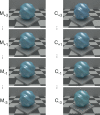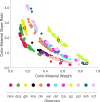The relative contribution of color and material in object selection
- PMID: 30978187
- PMCID: PMC6490924
- DOI: 10.1371/journal.pcbi.1006950
The relative contribution of color and material in object selection
Abstract
Object perception is inherently multidimensional: information about color, material, texture and shape all guide how we interact with objects. We developed a paradigm that quantifies how two object properties (color and material) combine in object selection. On each experimental trial, observers viewed three blob-shaped objects-the target and two tests-and selected the test that was more similar to the target. Across trials, the target object was fixed, while the tests varied in color (across 7 levels) and material (also 7 levels, yielding 49 possible stimuli). We used an adaptive trial selection procedure (Quest+) to present, on each trial, the stimulus test pair that is most informative of underlying processes that drive selection. We present a novel computational model that allows us to describe observers' selection data in terms of (1) the underlying perceptual stimulus representation and (2) a color-material weight, which quantifies the relative importance of color vs. material in selection. We document large individual differences in the color-material weight across the 12 observers we tested. Furthermore, our analyses reveal limits on how precisely selection data simultaneously constrain perceptual representations and the color-material weight. These limits should guide future efforts towards understanding the multidimensional nature of object perception.
Conflict of interest statement
The authors have declared that no competing interests exist.
Figures








References
-
- Wandell BA. Foundations of Vision. Sunderland, MA: Sinauer; 1995.
-
- Rodieck RW. The First Steps in Seeing. Sunderland, Mass: Sinauer; 1998.
-
- Olkkonen M, Ekroll V. Color Constancy and Contextual Effects on Color Appearance In: Kremers J, Baraas RC, Marshall NJ, editors. Human Color Vision. Cham: Springer International Publishing; 2016. p. 159–88.
Publication types
MeSH terms
Grants and funding
LinkOut - more resources
Full Text Sources
Other Literature Sources

